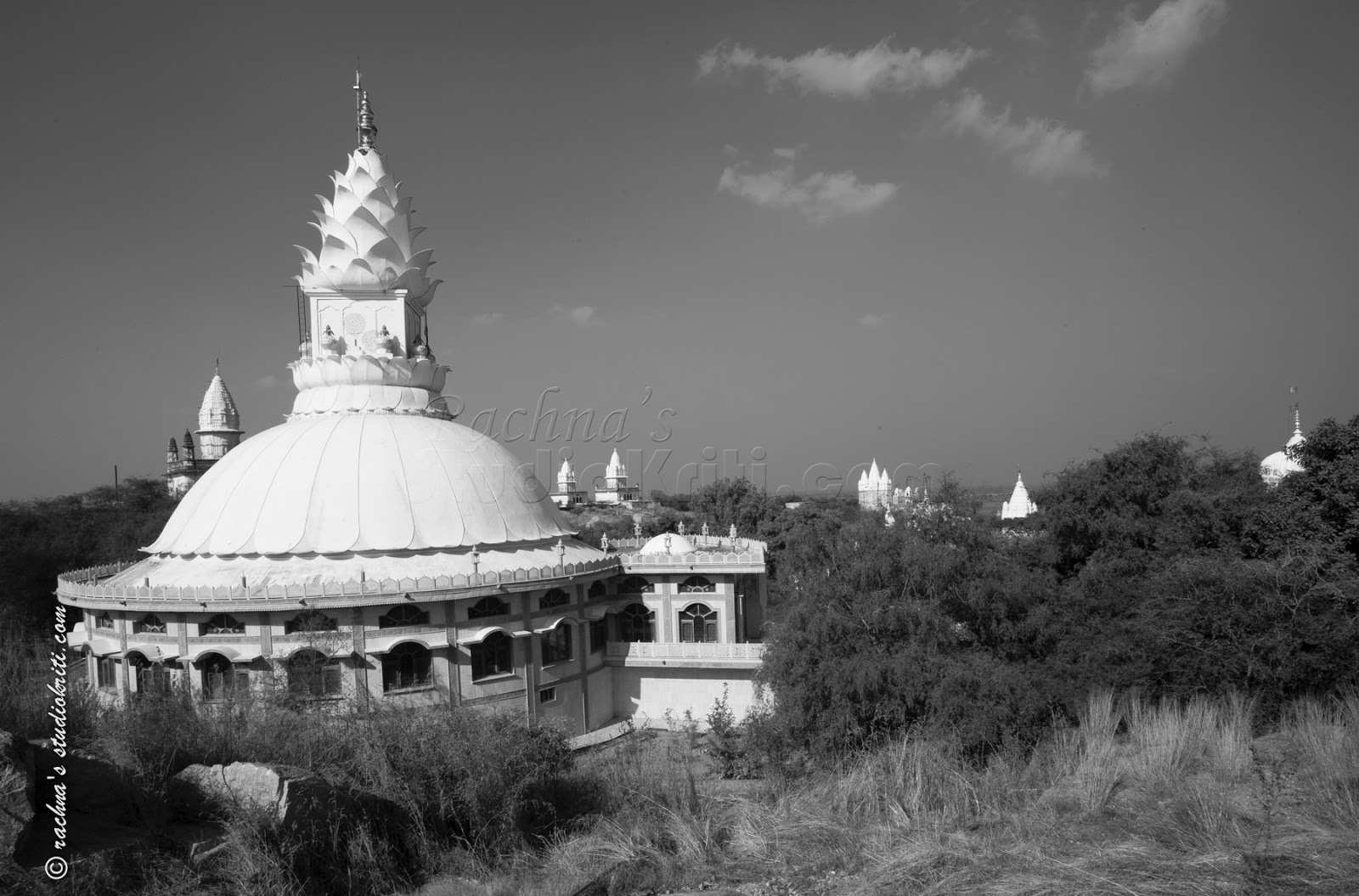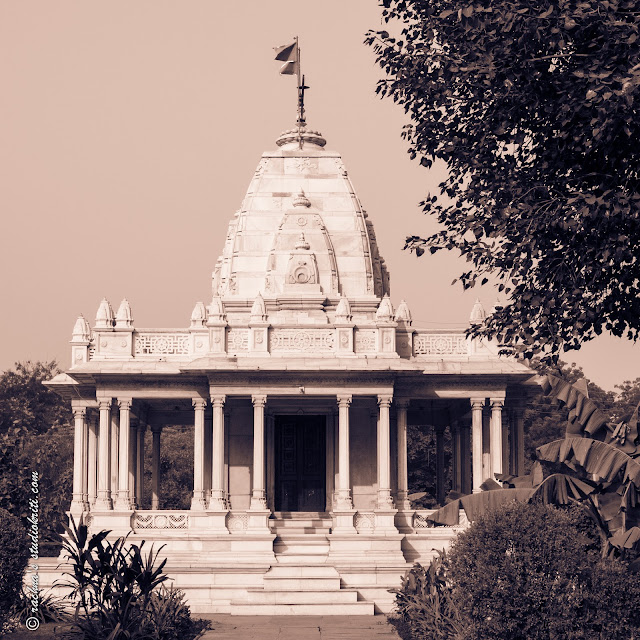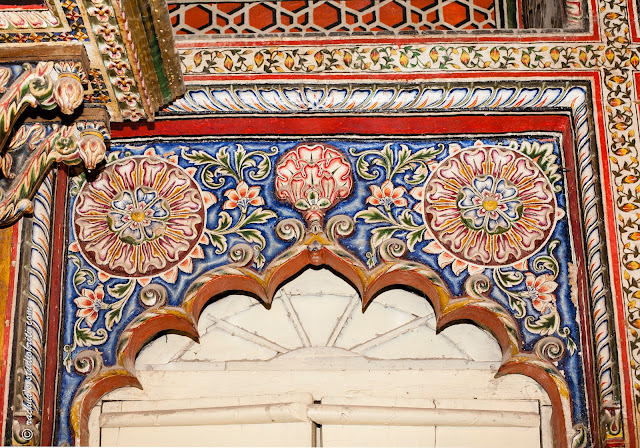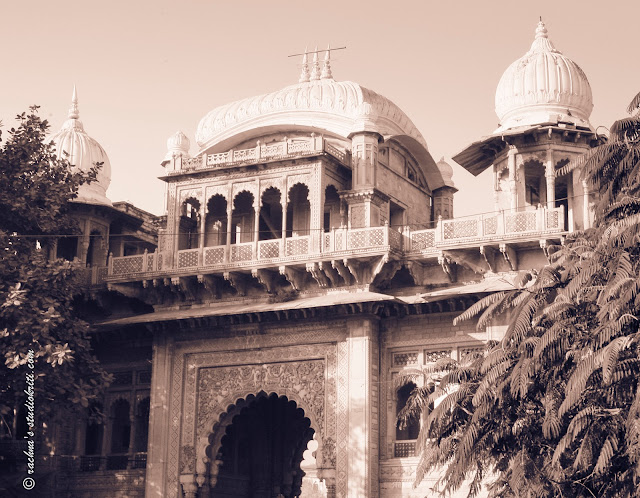The Temple Hill Sonagiri is a cluster of Jain shrines, sacred to the Digambar Jain sect, located about 70km from Gwalior, close to Datia. The hill known as Shravangiri earlier, has around 80 Jain temples of 9th and 10th century. This sacred place is popular among devotees and ascetic saints for practicing self-discipline, austerity and to attain Nirvana. The legend has that Chandraprabhu, the 8th Teerthankar, attained Moksha here along with "crores" of ascetic saints. The beautiful temples are spotless white, and vary in size and style.
February 1, 2014
January 17, 2014
Heritage Gwalior - Classical Music - The Legacy of Tansen
As a result of the continued patronage to Classical Music, right from the times of Raja Dongarendra Singh, mid 15th Century, Gwalior had been a land of accomplished Maestros of Indian Classical Music. During the time of Dongarendra Singh classical Indian music was sung in Sanskrit, although it was restricted to only those who had Sanskrit education, which were very few. Dongarendra Singh recognized it as a limitation and in his lifetime translated or created many "Vishnupad"s in Hindi and put into various classical Ragas, which were then understood and enjoyed by all. These Vishnupads were beautiful songs in praise of Lord Vishnu and His Avatars, mostly Krishna.
Later his descendant, Raja Man Singh uplifted this tradition even more when he encouraged Shringar(of beauty and romance) Rasa(emotional response) in the Ragas. This new revival of Indian classical music was also getting immense appreciation in Delhi court and else where. During this time great Maestro Haridas was teaching the most prominent music composer, singer of Hindustani music ever - Tansen, and his contemporaries. At the time when Sufi and other Persian styles were center stage and Ghazals, Qawwalis, Khayal were more popular in courts, the Hindustani school of music that was developing in Gwalior, contributed to by numerous accomplished and regarded maestros, became one of the earliest Gharanas of Hindustani Music. Man Singh even wrote an analytical and encyclopeadic book on Hindustani Classical Music - Man Kautuhal. Its is documented that out of the 15 most regarded music artists in the court of Akbar, 9 came from Gwalior, from Man Singh's patronage, including the Great Master Tansen. Man Singh is also credited for the revival of Raga Dhruva Pad, or Dhrupad. Although the Dhrupad can be traced back to Vedas, but Man Singh brought it mainstream and even created and published a lot Padas himself.
Although the royal patronage ended soon after the end of Tomars in Gwalior, the region still continued to have the lineage, and since music was deeply ingrained in the culture, Gwalior for a very long time continued to bring about great musicians.
The latest in this tradition is Ustad Amjad Ali Khan, the most illustrious Sarod player, who belongs to Gwalior, where his ancestral home now houses a unique museum of classical instruments used by current past Maestros. The museum is called "Sarod Ghar".
The ancestors of Amzad Ali Khan and the renowned Bangash family migrated from Afghanistan a few centuries back. The grand father of amzad Ali's great grand father, Mohammad Hashmi Khan Bangash, came from Afghanistan and settled in Rewa, around 400 kms from Gwalior. A horse trader by profession, he developed a deep interest in music. His dexterity on the folksy Rabab coupled with his interest in the Indian classical tradition led him to encourage his son Ghulam Bandegi Khan Bangash, to modify the Rabab into an instrument which could fuse the two traditions. This he did by introducing a metal fingerboard and strings to the rabab. His Son, Ghulam Ali Bangash, perfected the instrument and polished the practice of playing ragas on the Sarod as it was named, meaning 'melody' in Persian.
Ustad Amjad Ali Khan represents the sixth generation in this great tradition. His sons, Amaan and Ayaan, also accomplished sarod players in their own rights, are the seventh generation. The first instruments exhibited in Sarod Ghar were the instruments belonging to his forefathers. The rabab of Ghulam Bandagi Khan Bangash, the Sarods of Nanne Khan, Asghar Ali Khan and Haafiz Ali Khan are part of this collection.Subsequently, musicians and well-wishers from all over the country have come forward to contribute the instruments belonging to a number of great Masters and gurus of the past. The Collection now includes the Tanpura of Krishnarao Shankar Pandit, Violin of Allauddin Khan, the Tabla of Ahmed Jaan Thirakwa, Kanthe Maharaj and Kader Bux.
January 15, 2014
Heritage Gwalior - Stepping into Independent Democartic India
Jiwaji Rao Scindia who succeeded his father Madho Rao Scindia in 1925 was the last king of Gwalior, as the country became Sovereign and all princely states became part of the Republic of India. He practically ruled for a very short period of time as he was just 9 years old when he became the ruler, and then later the state was amalgamated to the nation, shortly 1947. In this short duration, that also saw the second world war, he carried the Scindia legacy forward, and worked for the betterment of his people.
He opened multiple schools and colleges, including the first medical and engineering colleges, brought many democratic processes further and made many administrative reforms as well.
The annual Trade Fair held at Gwalior, had by now grown leaps and bounds. Jiwaji Rao Scindia built permanent pavilions with paved roads over an area spread in more than 100 acres, including parks and other amenities, for traders and shops who would come from all over the country. Over the decades, it has become the biggest fair of Madhya Pradesh running for more than a century now, and, indeed, one of the most colorful fairs of the whole India. It starts in the second week of January and continues until February.
During this time, around 1925, another festival started being organized in Gwalior, that gained immense regard and adulation. That is the Tansen Music Festival, held every year around early December for few days, when the weather becomes quite nice in Gwalior. Every year, classical maestros from Hindustani as well as Carnatic disciplines, come to this festival of music to pay homage to the most revered legend of Indian Classical Music. The festival is held right next to the tomb of Muhammad Gaus and Tansen and people come and listen to the wonderful music all night long.
Chhatri Lawns Gate
Chhatri - Jiwaji Rao Scindia
Chhatri - Vijaya Raje Scindia, wife of Jiwaji Rao Scindia
Chhatri under construction - Madhav Rao Scindia, son of Jiwaji Rao Scindia
January 14, 2014
Heritage Gwalior - End of 19th Century - Stepping Into Modern Century
Jayaji Rao Scindia was succeeded by his son Madho Rao Scindia in 1886, when he was only 10 years old. He maintained the very friendly relationships with British and Gwalior saw a peaceful and prosperous time during this period, shielded from the upheaval the country was facing elsewhere. Madho Rao inherited a developed city, boasting of impressive palaces, administrative buildings, town halls, inns, hotels, temples. On this strong foundation, Madho Rao completely focused on improving the everyday conditions of his people. He opened various schools, colleges, did a great deal to improve modern industry, improve farming methods, and introduced directly and democratically elected Municipal Councils. The very first factory of the Birla group of Industries, JiyajiRao Cotton Mill was setup in Gwalior in 1918, by the founder Ghanshyam Das Birla. He made several canals for agricultural irrigation and also made Tighira dam and reservoir at a part natural, part man made lake. This dam even had a water filtration plant, which was quite a rarity at that time. This reservoir provides water for Gwalior city even today. He also made efforts to connect Gwalior with multiple railway lines during in late 19th century.
In 1887, Madho Rao laid the foundation of "Victoria College". Over a century old history of this great institution marks the various stages of its development and spread of higher education in Gwalior. It was actually a smaller institute called "Lashkar Madarsa" established much earlier, in 1846. The beautiful building was completed in 1899 and was inaugurated by the then Viceroy of India, Lord Curzon, in 1899. In 1957 its name was changed to “Maharani Laxmi Bai Arts and Commerce College” in the memory of that great, valiant and immortal freedom fighter, the Maharani Laxmi Bai of Jhansi.
The Scindia Boys Residential School was established in 1897, then named "Sardar School", on the Gwalior Fort. It was initially meant exclusively for sons of Indian princes and nobles.
Chhatri of Balwant Rao, elder brother of Madho Rao Scindia
Madho Rao Scindia had a deep compassion for the farmers and small artisans of his land. During that time Gwalior faced extreme drought conditions often accompanied by famine. Madho Rao worried about how to help them and improve their condition. In 1905 he started the annual Gwalior Fare to boost the economic activity of the farm and other local skills sectors. Initially the Fare was only to buy and sell cattle and farm equipment. With each passing year the Fare gained popularity and the scale of the Fare widened to include various other kind of shops, including food and entertainment from towns and cities near and far. Over the decades it has become the biggest fair of Madhya Pradesh and, indeed, one of the most colorful fairs of the whole India.
Heritage Gwalior - Late 19th Century - Building of City Gwalior
Jayaji Rao Scindia who succeeded the short rule of Jankoji Rao Scindia, was only 8 years old when he was made the official king, in 1843. He ruled Gwalior for a relatively long period of 43 years, till 1886. During this period he built most of the modern day Gwalior, and those buildings are, not only present, but are being used in various ways even today. Jayaji Rao maintained friendly relationship with British and used the bargained peace to develop his city.
The first palace he made is Moti Mahal, a mansion with nine hundred rooms. It draws inspiration from the medieval buildings in Gwalior and has an oriental ambience with terraces flanked by square towers. The reflection of the palace looks beautiful on the artificial lake on the front. Later, Maharaja Madhavrao Scindia converted it into secretariat of Gwalior Riyasat. It was known as "Huzoor Secretariat". The palace features mosaic work of colored glass and gold leafing, and murals depicting Ragas and Raginis. The palace also has a rich collection of wall paintings. The palace is used as a number of State Administrative offices today.
Durbar Hall
Everyday Sarkari Office amidst Heritage Art
The Magnificent Great Room now used as Another Conference Hall
Amazingly beautiful Music Room, covered with wooden panels with very intricate miniature paintings all over, depicting life and times of Scindias in Gwalior
Later he made a much more magnificent palace, with heavy European influence on architecture, the Jai Vilas Palace, that is functional even today. Part of this palace serve as residences of various Scindia family members and part of it is converted into a museum maintained by Scindia trust. The museum has a medley of furniture and objects used by the multiple generations of Scindias, quite a few gifts received from British and other European royalties, and an unapologetic display of tens of stuffed tigers as royal hunting trophies.
Other than palaces, Jayaji Rao made multiple prominent buildings in various archetectural styles, to develop the town center, including comomorative Gates, administrative buildings, inns etc. He also made a number of temples around the town.
The Regal Theatre
The Gorkhi Gate
The Victoria Market
Now burnt down by an accidental Fire!
Krishna Temple at Gorkhi
Many of these beautiful heritage monuments and buildings are ridden with modern day thoughtless ugliness. Is it not possible to be mindful of putting hideous objects next to them and ruin their beauty. Is it not possible to clean and develop beautiful parks around some of such commemorative Gates for example, and may be even lease them out to cafes and restaurants, to earn some profit to maintain them. if such buildings are made part of people's everyday life, they will get much more value and love from common people.
Gate of the inn "Duffrin Sarai"
Subscribe to:
Comments (Atom)
































































